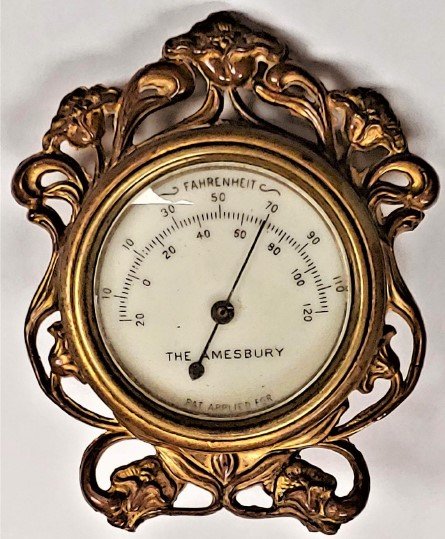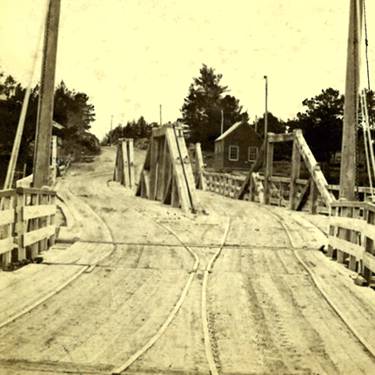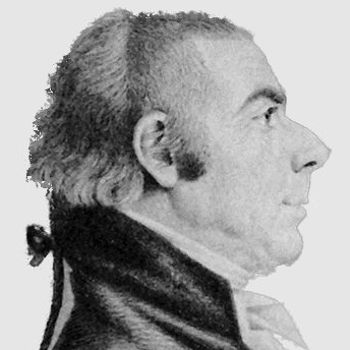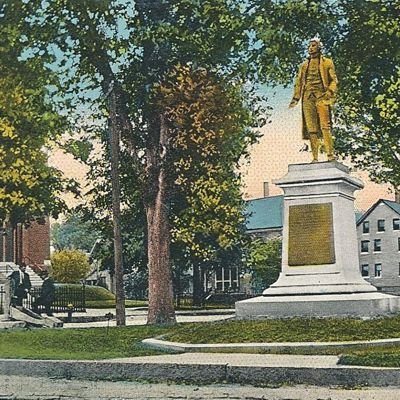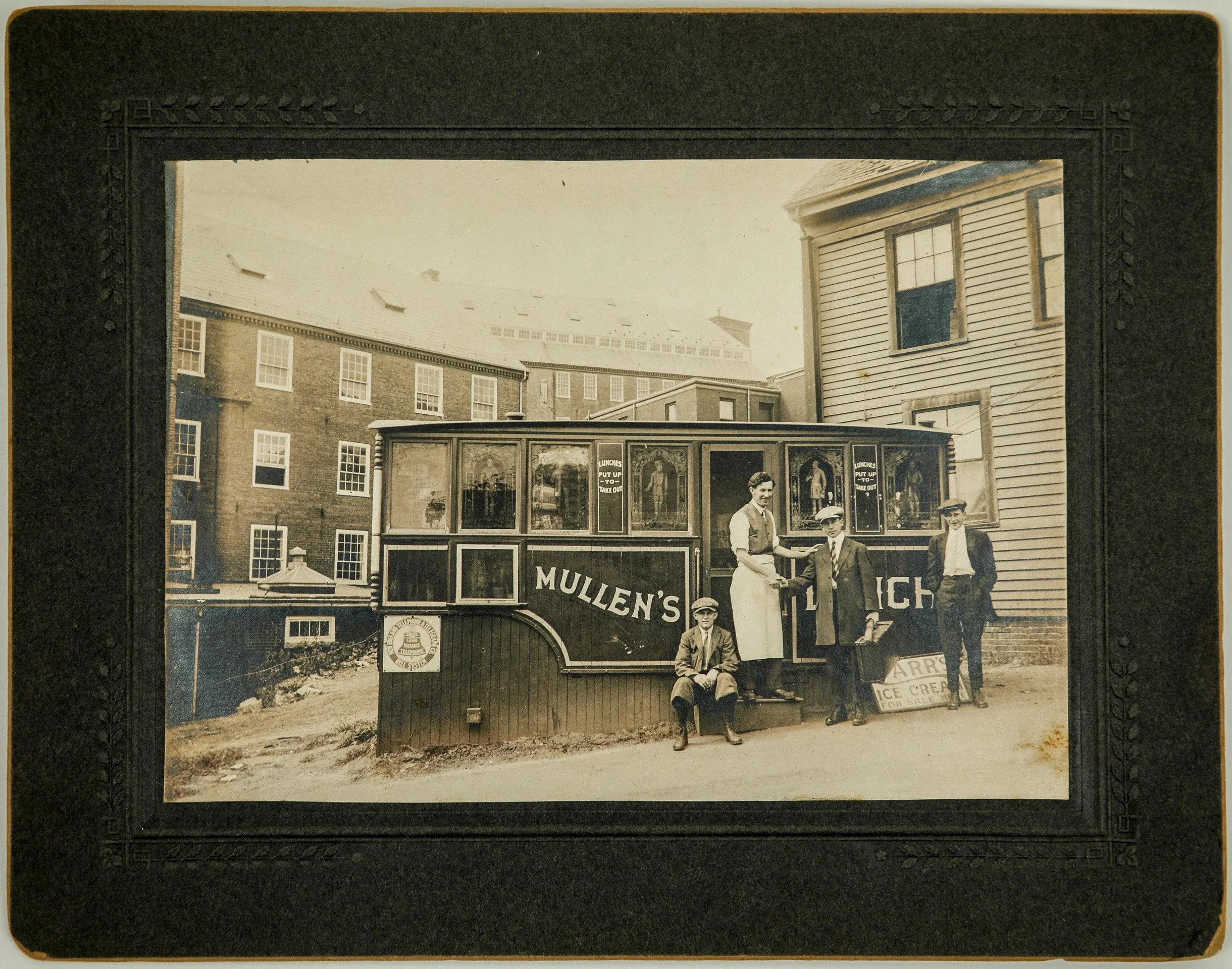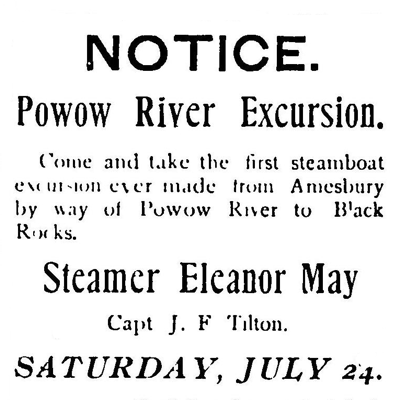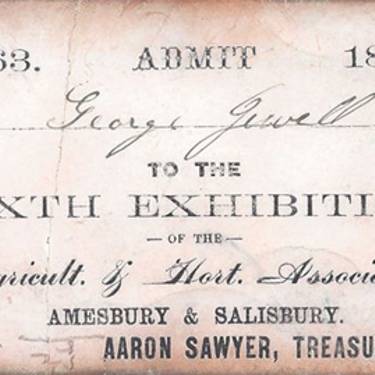The rapid fall of the water, the dams at very short distances crossing the river…give this place one of the most singular views to be found in this country.” – 1792 Topographical Sketch of the County Essex
Researching People & Place
researching people & place
Enjoy browsing an entire collection of free, downloadable articles produced by the members of our Industrial History Survey Group. The articles are organized under the following categories:
Transportation people infrastructure places
The Industrial History Survey Group was started when a group of industrial history enthusiasts decided to start getting together to share their research projects and visit local sites to gain a better understanding of the built environment of Amesbury. They meet monthly at our Industrial History Center. This dedicated team of volunteers share their passion for history not just with each other, but with the wider community, by making their work available through ACM. Many of our programs, exhibits, tours, and lectures are a result of their work.
Members: Ken Aspeslagh, Greg Colling, Francis Gurczak, Mike Harrold, Josh Jackson, Ron Klodenski, Steve Klomps, John Mayer, Tom Murphy, Lawrence Pearl, Joyann Reynolds, Robert Schoen, and Dan Staats
Transportation
Carriages, automobiles, bicycles, and railroads
Manson & Co. Express - Elm Street and Merchants' Row
A poster recently discovered on a local carriage house wall advertises "Manson & Co's Amesbury, Salisbury and Boston Express." Learn about Manson, his family tree, his delivery business, the express business in general, and some interesting background on Merchants' Row in Amesbury's Market Square.
Nature & Distribution of Individual Amesbury Carriage Makers Across Segments of the Trade
Explore the internal operation of Amesbury carriage making, what functions individual makers did or did not perform in their part of the process, and where they fit in various hierarchies of the business. This report presents the distribution and use of labor, materials, and horsepower that evolved over several decades of responding to changing economic conditions.
Quick Guide to Amesbury Carriage Makers
Production volume, labor content, and carriage pricing, showing how strata of labor content vs. annual production volume evolved with shifting economies from 1870 to 1888, along with associated carriage pricing.
ACCOUNT BOOK - Carriage Maker Moses M. Dennett
An analysis and transcription of the Moses M. Dennett account ledger (1890-1893). Dennett was a carriage maker in Amesbury both before and after the devastating fire on Carriage Hill in April of 1888. The ledger gives a unique look at Moses Dennett’s last three and a half years of carriage making, and offers a glimpse into his business. The ledger, donated to ACM in 2021, was stabilized conserved with funds donated by descendants of Dennett. This transcription was also made possible by the hard work of the Dennett descendants.
Complete Automobiles Made in Amesbury
A few Amesbury companies and individuals proposed or built complete automobiles – not just auto bodies – in the early 1900s.
The Carriage Making Industry of Amesbury
Carefully researched and analyzed overview of the Amesbury carriage business and how it fit into the immense nationwide carriage industry. Discusses business functions, working environment, distribution, size, methods, production, products and pricing.
Bicycles in Amesbury
Ingenious and skilled Amesbury people like George Knights brought the short-lived bicycle manufacturing industry to town in the late 1800s, helping to ease the economic transition from carriage making to auto body building.
Introduction to Amesbury Industries, 1790-1930
Growth and decline of textile, carriage and auto body industries in Amesbury. Includes maps and statistical data from multiple sources.
The T. W. Lane Family of Carriage Makers
Thomas W. Lane (1840-1935) was a highly successful Amesbury carriage manufacturer who pioneered the assembly of components manufactured by others to produce high volumes and varieties of carriage models.
History of the Salisbury Point Railroad Depot
This resilient little railroad depot started its life 150 years ago next to the rail crossing on Rocky Hill Road, behind today’s Dunkin Donuts. Follow the many relocations and reinventions that brought it, finally, to Amesbury’s Lower Millyard.
People
Business Leaders, Labor, and Innovation
John S. Poyen & Co., Purveyor of Carriage Materials
John Saint Sauveur Poyen (1819-1880) became a successful supplier of carriage hardware and fabrics to carriage makers in Amesbury and Merrimac. He was also the first of five sequential male generations bearing his name.
Howard F. Currier, An Amesbury Photographer of the Civil War Era
A portrait of Lincoln assassin John Wilkes Booth with the name of Amesbury photographer Howard F. Currier on the back led to an investigation into a connection between the two men.
Patrick Henry Connor, Amesbury Carriage Maker
A comprehensive overview of the personal life and career of Patrick Henry Connor (1856-1904), known as the manufacturer of Amesbury’s finest carriages.
Jacob Perkins & Amesbury Industrial Nail Manufacture
Jacob Perkins, an obsessive inventor and tinkerer, established the world’s first industrial nail factory in Byfield, Mass., in 1794. His operation moved to Amesbury in 1796 to take advantage of better water power and access to shipping by water. Perkins’s nail-manufacturing advancements were just a part of the growing New England nail-making industry.
The Derby Lockout and Strike of 1852
This comprehensive paper presents the details of an Amesbury mill-workers’ action in the days before labor unions were common and workers had little bargaining power in disputes with management.
Blasdel clockmakers of amesbury
David Blasdel (1712-1756) and his sons, David Jr., Isaac and Jonathan, were early Amesbury clockmakers. Some of their creations are still in running condition today.
J.J. Allen: Chronicler of Carriages and Auto-Bodies
Local historians are indebted to John J. Allen for his encyclopedia of Amesbury places, people and companies associated with the town’s carriage and auto-body industries. He also served Amesbury citizens in many other ways.
Swan Song: The Derby Strike Riot
Young Austin Swan only asked the female mill workers to join an 1852 walkout, but was charged with participating in a “riot” near the entrance to Amesbury’s upper millyard.
The Female Operatives and the Derby Strike: Their Story
Until now, little has been published about female factory worker involvement in Amesbury’s historical 1852 Derby Strike labor dispute.
Frank A. Babcock: Carriages, Buildings and Cars
Story of Frank Babcock, who built the largest carriage factory in Amesbury’s history and then left town to create a highly successful electric auto manufacturing company.
Amesbury Thermometer Company
Growing popularity of an accurate and convenient method of determining temperature – the bimetallic thermometer – made possible a short-lived but prosperous business called Amesbury Thermometer Company. It operated from 1903 to 1913.
Amesbury Spark Plug Manufacturers
The stories of four innovative companies developing and manufacturing automotive spark plugs in Amesbury between 1902 and 1915.
Moses Dennett’s Early Years and Civil War Service
Moses Dennett (1841-1930) became a successful Amesbury carriage manufacturer and community leader, but traits that led to his success and earned him the town’s reverence were visible in his youth and his service as a young soldier in the Civil War.
Jonathan Webster’s Steam Machinery Factory
Community and family relationships, along with steam power and his own talent and drive, propelled Amesbury’s Jonathan Webster to great success in manufacturing, utilities, banking and insurance.
An Early Photograph of Abner Bailey
A chance discovery sparks research into the life of Abner Bailey, the Merrimac Hat Company, and Amesbury Photographers.
The Story of Hiram Craig Gardner, Horticulturalist
Hiram Gardner’s home and gardens on Elizabeth Street in Amesbury were filled with plants, flowers, and vegetables that should NOT have been growing in Amesbury.
Margaret Maginley: A Woman in Amesbury’s Industrial History
In the late 1800's, an Amesbury woman named Margaret Maginley took over her husband's business and operated it successfully for 15 years.
Infrastructure
Mills, Utilities, Bridges
What We See Now vs. What Was
Most of the grand buildings from Amesbury’s industrial heritage have disappeared, leaving only drawings and photographs to remind us of the busy manufacturing days of the past.
Windmills in Amesbury
In the 1880s and 1890s, before the town’s public water distribution center had been developed, windmills were springing up all around Amesbury for pumping water from private wells to supply running water to kitchens and bathrooms of some wealthier households. Most ordinary residents of the time drew water from public or private wells using hand pumps.
Powow River Horsepower from 19th Century Textiles to 20th Century Electric Power Utility
Estimated horsepower actually produced by Powow River water over its industrialized history.
The Rise of Textile Mills Along Amesbury’s Powow River
Before they were repurposed for carriage building and other businesses, most of the brick buildings still standing along the Powow River in downtown Amesbury were built for manufacturing textiles such as wool and cotton cloth. Amesbury played an important role in developing the textile industry, which transformed the region’s economy and culture from agriculture to manufacturing.
Some Amesbury Wastewater Treatment History
How today’s invisible sewer and wastewater systems evolved from primitive methods of waste collection, transport and disposal.
History of Amesbury Water Distribution Systems
History of Amesbury’s water and wastewater distribution systems from the 1800s to present day. Traces system evolution from fire-fighting to a public health and convenience necessity.
Amesbury-Newburyport Chain Bridge 1810-1909
History and construction details of the historical suspension bridge connecting Amesbury to Newburyport. Includes general information about suspension bridge engineering and history.
Merrimack River Bridges at Deer Island
History of bridges crossing the Merrimack River from Amesbury to Deer Island with photos and explanatory text. Includes photos and information about the Chain Bridge connecting Deer Island to Newburyport.
Stone Arch Bridges in Downtown Amesbury
Without knowing, many of us pass over some impressive granite stone bridges in the center of Amesbury almost daily. Many have seen the picturesque Pond Street Bridge, visible from the Upper Millyard. But two others, under Main St. and Elm St., are hidden from view and mostly unknown.
Timothy Palmer and His Bridges
Timothy Palmer is known locally for designing some of the first bridges spanning the Merrimack in Amesbury and Haverhill. But he also constructed others in New Hampshire, Philadelphia and elsewhere in the East.
Amesbury Industrial Database to 1930
Maps and tables show locations and operating periods of Amesbury textile, carriage-making and other businesses to about 1930.
The 200th Anniversary of Mill 3
2020 marks the 200th anniversary of Mill 3, Amesbury’s oldest existing mill building and now home to Ben’s Uniforms on Main Street.
A Mill 2 Scrapbook
An introduction to Amesbury’s most prominent landmark building, Mill 2, (now Amesbury Industrial Supply Co.). This historic structure has dominated the city skyline for nearly 200 years, and it’s also the new home of the Industrial History Center.
places
Evolution of a Neighborhood: Environs of School Street and Saint Joseph’s Church
A pictorial chronology of the School Street neighborhood in the heart of Amesbury, including its most prominent and enduring feature, Saint Joseph’s Church campus. Also presents history of some local families, events, and circumstances describing and evolution of this neighborhood.
Factories of Patten’s Pond & Mechanics Row
In the late 1800s, an industrial center grew up in the area around Patten’s Pond on Main Street, near the site of today’s post office. Hardly any evidence remains from this bustling complex where carriages, carriage-making machinery, metal castings, thermometers, bicycles, and other products were manufactured between 1870 and 1928.
chain bridge & Hawkswood castle
Few traces of Hawkswood Castle remain today. Hawkswood was an estate on the Merrimack River at the east end of Amesbury’s Point Shore and visible in some old photos of the Chain Bridge connecting Amesbury to Newburyport.
Salisbury Beach: A Destination Since the 1850’s
Only short trip from Amesbury, Salisbury Beach offered ocean air, cool surf and a variety of entertainment during summer’s stifling heat.
Envisioning Carriage Hill Development Prior to the Fire of April 5, 1888
Amesbury’s Carriage Hill industrial area was completely transformed by the disastrous 1888 fire, but few photos had been taken to show how the district looked before the fire. By examining the backgrounds and edges of old photos and drawings made for other purposes, Mike Harrold has constructed a visual history of the largely forgotten pre-fire carriage-making center.
Moses Dennett and the Carriage Hill Fire
Moses Dennett devoted much of his life to establishing his carriage making business, only to see his factory destroyed in the Carriage Hill fire of 1888. Accepting his fate and moving on with his life, he became known as “Amesbury’s Grand Old Man.”
The Dennett Home on Powow Hill
Amesbury carriage-maker Moses Dennett moved into his impressive home on Powow Hill in 1887. His great-grandson scoured deeds, newspapers old maps and other documents to find the old house – still standing proudly.
Boston Newspaper Illustrations of the Amesbury Carriage Making District
In the 1880s, Amesbury and its booming carriage industry were written up in several Boston newspapers. These articles often featured artists’ drawings copied from photographs, which could not be reproduced in newspapers in those days. This report shows several of these sketches, some of the great 1888 fire, along with the photos from which they were copied.
The Docks of Amesbury and Salisbury Mills
Hidden from view and largely forgotten, the two miles of tidewater Powow River between downtown Amesbury and the Merrimack River was once a busy transportation artery connecting the town’s industries and shipyards with the rest of the world.
Last of the Textile Mill Row Houses
The neighborhoods on Aubin, Mill and Clay streets near downtown Amesbury were once crowded with company-owned rowhouses for those who worked in the Hamilton Woolen Co. textile mills in the upper and lower millyards. Only one of these structures still survives.
Amesbury & Salisbury Agricultural Society
Maps and photos show the agricultural society’s exhibition hall and fairgrounds between Market Street and Southampton Road. This important Amesbury feature stood for about 50 years, starting in the late 1800s.
Envisioning Railroad Avenue Development
Railroad Avenue is now an inconspicuous street leading only to the Costello Transportation Center and the N. A. Nichols scrap metal facility. But it once extended almost to Chestnut Street and provided access to a railroad yard, some mills and a rail passenger depot.
Evolution of Mill 3 1/2
Now a mostly wood-sided building, a brick facade hints at the past of this former mill building pictured behind Mullen’s lunch car. Explore the history of the structure and its changing uses through maps and photographs.






















